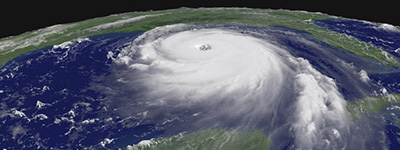
Hurricanes are tropical cyclones - storms that rotate counter clockwise with wind speeds in excess of 74 mph (kmh). Most hurricanes form over warm seas near the equator. They are created when the sun heats the ocean surface, causing heated water vapor to rise, condense and form clouds. These clouds begin to spiral as the earth rotates causing air to be pulled underneath and a large vortex is formed.
They form in the southern Atlantic Ocean, Caribbean Sea, Gulf of Mexico, and in the eastern Pacific Ocean. A tropical cyclone is accompanied by thunderstorms, and in the Northern Hemisphere, a counterclockwise circulation of winds near the earth's surface
On average, six (6) Atlantic hurricanes develop each year. When a hurricane moves toward populated coastal areas it often causes severe damage. Strong winds create storm surges, floods, and even spawn tornadoes. As the hurricane moves forward, its right front quadrant is typically where the most devastation occurs.
Over land, hurricanes lose their strength as the heated water that sustains it is no longer available to support it.
Hurricanes are strong storms that cause life and property threatening hazards such as flooding, storm surge, high winds and tornadoes. Preparation is the best protection against the dangers of a hurricane
Hurricane season is June 1 - November 30. There is typically more rain during this period, even if a hurricane does not develop.
